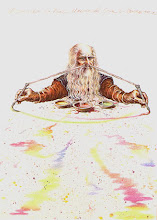 In the last blog i was referring generally to Pierrot.i will have now a deeper look at him.
In the last blog i was referring generally to Pierrot.i will have now a deeper look at him.in this quest of deciphering Pierrot,i am not hesitating to find some psychoanalytic lines to his character.this is much the influence of Lacan and Zizek,who i am influenced by in my analytic prism.their point of view is ,not only looking at the material itself and the way of its development into a meaningful item ,but also the deep and obscured psychic backgrounds of the exhibit.
before getting to the music itself, I look around to the characters who created the final Pierrot as we encounter in Schoenberg piece. I see much the structure of the piece as organized by Schoenberg.
I review the other pieces written by Albert Giraud, such as the sequence to Pierrot:
Pierrot the narcissist- a drama in which we see Pierrot years after we had met him for the first time. he is already fed up with everyone.the lunar madness became narcissism. you can read the play in the link and judge for yourself the situation of which a denied person had turned into.
as i have written in the previous blog,no more humanism.the rise of selfishness!
as you might have noticed while opening the links ,the piece consists of 21 poems.
(and this is one of the most clear webliographies for that-both the translation and the original text, the music-though not the most great performance,but didactic and efficient)
In the 1st part (the first seven poems) the yearning for love - (of a woman-Columbine or Aliane) - and the fulfillment of those passions in a physical way described in metaphoric abstract. (bear in mind that in that time, Arnold`s Schoenberg’s wife –left him with his daughter.)Tender fantasies which can be understood as great pain
The 2nd part is the disappointment of fellow mankind and shouting visions of violence to all. (Bear in mind the divorce and the critics who did not approve of this kind of music) blasphemy-the twilight of religion.
The 3rd part is the nostalgia.that strong feeling rises to most of us, when we are alone, and have only ourselves to ourselves and we self pity.
Again the wife left, the critics don’t like your art. What is the art you yourself you like? How can you create some message which will come thorough to people? how can this freedom of new style created can charm the vast audience?understood?
This is to be locked in a big white room all by yourself and no-one to talk to.
We, the audience, are evil, we are cruel. We are miserable.we want companionship and comforts to our loneliness.we want to be the leaders. We want to be understood. We hate all those who mock our effort to think outside the box. When it does not work. we refer to one of the most painful feeling ,the nostalgic-pay attention that in this part of Pierrot –there are a lot of known patterns coming to our ears:form the barcarole(finally something which resembles a “normal melody”) alter duft(mein sinne-melody with implied harmony) the waltzer etc.
Pierrot uses three colors: white black and red. (Familiar?)
Red is the passion –the blood, the violence. The power. as an aesthetic mechanism,it is the color which inserts dynamic into the plot(visually speaking-cinematographic or art etc.)
White is the relaxation, the nostalgia-the stage. -
Black –is the violence, the big nothing, the abyss of fear, the loneliness.
in a Zizekien manner,it is the ego,alter ego and super ego.perfect psychopath.
we can see so far that not only Pierrot is far from what we knew about him as the crying clown(see all the nice,soft melancholic images of the classic Pierrot) but is pretty much a result of a persona who is submissive to the crowd.the unwanted underdog,the looser, turns into the psychopath,lonely,blood thirsty, selfish,low self esteemed person,artist who nobody cares to understand.
and we made him as such.
in the next blog i will approach what i have written so far, its translation to music itself.





No comments:
Post a Comment